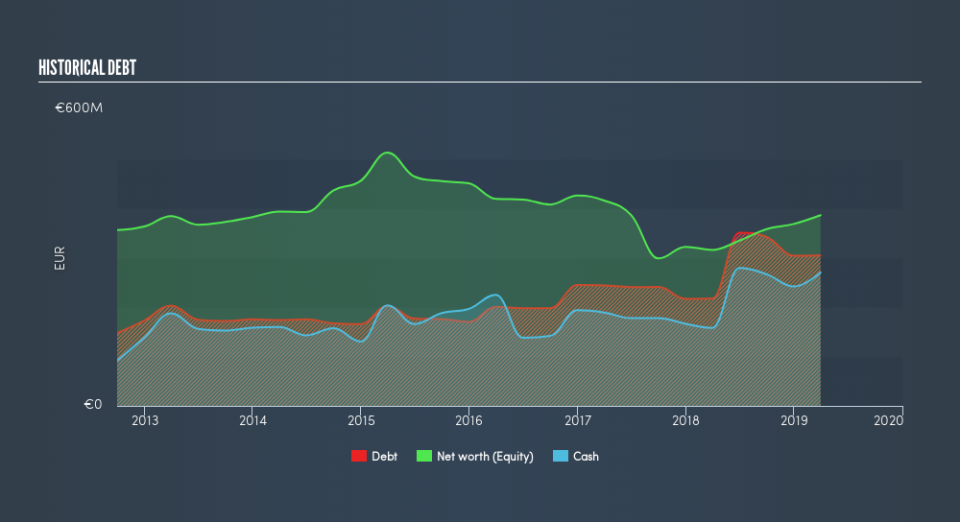Here's Why Schoeller-Bleckmann Oilfield Equipment (VIE:SBO) Can Manage Its Debt Responsibly

The external fund manager backed by Berkshire Hathaway's Charlie Munger, Li Lu, makes no bones about it when he says 'The biggest investment risk is not the volatility of prices, but whether you will suffer a permanent loss of capital.' So it might be obvious that you need to consider debt, when you think about how risky any given stock is, because too much debt can sink a company. We can see that Schoeller-Bleckmann Oilfield Equipment Aktiengesellschaft (VIE:SBO) does use debt in its business. But is this debt a concern to shareholders?
What Risk Does Debt Bring?
Debt assists a business until the business has trouble paying it off, either with new capital or with free cash flow. Ultimately, if the company can't fulfill its legal obligations to repay debt, shareholders could walk away with nothing. However, a more frequent (but still costly) occurrence is where a company must issue shares at bargain-basement prices, permanently diluting shareholders, just to shore up its balance sheet. Of course, plenty of companies use debt to fund growth, without any negative consequences. When we think about a company's use of debt, we first look at cash and debt together.
View our latest analysis for Schoeller-Bleckmann Oilfield Equipment
How Much Debt Does Schoeller-Bleckmann Oilfield Equipment Carry?
You can click the graphic below for the historical numbers, but it shows that as of March 2019 Schoeller-Bleckmann Oilfield Equipment had €304.3m of debt, an increase on €217.5m, over one year. However, it also had €270.0m in cash, and so its net debt is €34.3m.
How Healthy Is Schoeller-Bleckmann Oilfield Equipment's Balance Sheet?
Zooming in on the latest balance sheet data, we can see that Schoeller-Bleckmann Oilfield Equipment had liabilities of €296.3m due within 12 months and liabilities of €254.0m due beyond that. Offsetting these obligations, it had cash of €270.0m as well as receivables valued at €135.0m due within 12 months. So it has liabilities totalling €145.3m more than its cash and near-term receivables, combined.
Since publicly traded Schoeller-Bleckmann Oilfield Equipment shares are worth a total of €941.0m, it seems unlikely that this level of liabilities would be a major threat. But there are sufficient liabilities that we would certainly recommend shareholders continue to monitor the balance sheet, going forward.
In order to size up a company's debt relative to its earnings, we calculate its net debt divided by its earnings before interest, tax, depreciation, and amortization (EBITDA) and its earnings before interest and tax (EBIT) divided by its interest expense (its interest cover). Thus we consider debt relative to earnings both with and without depreciation and amortization expenses.
While Schoeller-Bleckmann Oilfield Equipment's low debt to EBITDA ratio of 0.28 suggests only modest use of debt, the fact that EBIT only covered the interest expense by 4.9 last year does give us pause. So we'd recommend keeping a close eye on the impact financing costs are having on the business. Importantly, Schoeller-Bleckmann Oilfield Equipment grew its EBIT by 61% over the last twelve months, and that growth will make it easier to handle its debt. The balance sheet is clearly the area to focus on when you are analysing debt. But ultimately the future profitability of the business will decide if Schoeller-Bleckmann Oilfield Equipment can strengthen its balance sheet over time. So if you're focused on the future you can check out this free report showing analyst profit forecasts.
Finally, a company can only pay off debt with cold hard cash, not accounting profits. So it's worth checking how much of that EBIT is backed by free cash flow. Looking at the most recent two years, Schoeller-Bleckmann Oilfield Equipment recorded free cash flow of 32% of its EBIT, which is weaker than we'd expect. That weak cash conversion makes it more difficult to handle indebtedness.
Our View
Schoeller-Bleckmann Oilfield Equipment's EBIT growth rate suggests it can handle its debt as easily as Cristiano Ronaldo could score a goal against an under 14's goalkeeper. But, on a more sombre note, we are a little concerned by its conversion of EBIT to free cash flow. Looking at all the aforementioned factors together, it strikes us that Schoeller-Bleckmann Oilfield Equipment can handle its debt fairly comfortably. Of course, while this leverage can enhance returns on equity, it does bring more risk, so it's worth keeping an eye on this one. Above most other metrics, we think its important to track how fast earnings per share is growing, if at all. If you've also come to that realization, you're in luck, because today you can view this interactive graph of Schoeller-Bleckmann Oilfield Equipment's earnings per share history for free.
If, after all that, you're more interested in a fast growing company with a rock-solid balance sheet, then check out our list of net cash growth stocks without delay.
We aim to bring you long-term focused research analysis driven by fundamental data. Note that our analysis may not factor in the latest price-sensitive company announcements or qualitative material.
If you spot an error that warrants correction, please contact the editor at editorial-team@simplywallst.com. This article by Simply Wall St is general in nature. It does not constitute a recommendation to buy or sell any stock, and does not take account of your objectives, or your financial situation. Simply Wall St has no position in the stocks mentioned. Thank you for reading.

